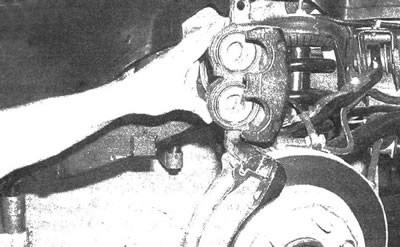Warning: brake pads are replaced in pairs on both wheels of one axle. Do not replace brake pads on just one wheel. Remember that dust generated by wear on the pads poses a health hazard. Do not blow it off with compressed air or inhale dust. When servicing the brake system, it is recommended to wear a protective mask or respirator. Do not use benzene or solvents to wash off dust from the pads. Use only a special cleaner to clean brake system components.
Note: This procedure applies to front and rear brake pads.
1. Remove the master cylinder reservoir cap. Pump out about 2/3 of the liquid and replace the lid.
Caution: Brake fluid can damage your vehicle's paintwork. If liquid gets on the body surface, wash it off immediately with clean cold water.
2. Loosen the nuts of the front or rear wheels, jack up the front of the car and install special supports. Place chocks under the wheels of the opposite axle.
3. Remove the wheels. Work on only one brake at a time, using the second brake for visual comparison if necessary.
4. Carefully inspect the brake disc as described in subsection 5. If machining is necessary, remove the disc as described below in this subsection.
5. Replace the pads using the accompanying illustrations (see illustrations). Do not violate the recommended sequence of the procedure, and strictly follow the instructions given in the comments under the illustrations.

3.5a. Before disassembling the brake, clean its parts using a special product and wait until the elements are completely dry; to catch the draining cleaner, place a container under the brake; DO NOT blow off brake pad dust with compressed air

3.5b. Push in the piston (And) into the caliper to create the clearance required when installing new pads. To do this, use a C-clamp before removing the caliper and pads. When the piston is depressed, the level of brake fluid in the master cylinder reservoir will increase. Do not allow liquid to overflow from the reservoir. Apply pressure gradually, in small increments, and constantly monitor the level in the master cylinder reservoir

3.5s. Front Brake Caliper Parts: A Fastening bolts; B Bolt of the brake supply hose fitting; C Caliper Bracket Bolts

3.5d. When replacing the front brake pads, it is necessary to unscrew the lower mounting bolt and, turning upward, secure the caliper in this position. When replacing the rear brake pads, it is necessary to fix the caliper guide pin with an open-end wrench, unscrew the upper mounting bolt with another wrench and turn the caliper down to gain access to the pads

3.5e. Remove the inner brake pad

3.5f. Remove the outer brake pad

3.5g. Remove the upper and lower brake pad holders located on the caliper bracket; if the holders or brackets have cracks or signs of deformation, replace them

3.5h. Apply brake squeal preventer to the back of both pads (wait for the product to harden for a few minutes, and then install the pads)

3.5i. Install the upper and lower pad holders to the caliper bracket

3.5j. Install the internal...

3.5k....and the outer block

3.5l. When replacing the front pads, it is necessary to inspect the caliper mounting bolt for signs of material wear and corrosion, after which it is necessary to lubricate the fasteners with heat-resistant grease for brake system elements (if the bolt was not covered with grease, turn the caliper up again, pull the upper mounting bolt out of the bracket and also lubricate it). When replacing rear pads, it is necessary to inspect the guide pin and rubber boot, and then lubricate the pin with heat-resistant grease for brake system elements (If the upper pin is not covered with grease, perform the described operation on the guide pin)
6. When installing the caliper, tighten its mounting bolts to the required torque. Tighten the wheel nuts to the torque shown in Chapter 1 specifications.
7. After completing the procedure, press the brake pedal several times to bring the brake pads into contact with the discs. Check the brake fluid level and raise it if necessary (see chapter 1). Before entering the roadway, make sure that the brake system is working and effective.
